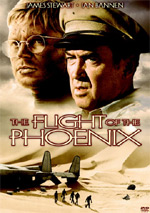
| The following reviews of new and classic genre movies, television series or tv-movies, books and magazines, comic books and graphic novels, video and dvd releases, cds and cd-roms, and internet sites, were written by members of this club during the years 2003 to present. If you are a member of Star Base Andromeda and would like to submit a review for consideration for this website, please contact us at the club's official e-mail account. Opinions expressed in the reviews on this website are solely those of the individual reviewer, and do not reflect the views of the membership of Star Base Andromeda as an organization. | |
|
|
| |
BOOKS |
| |
MOVIES |
Flight of the Phoenix [1965]Flight of the Phoenix [2004] |
-- reviewed by Scott Clark |
  ***
THESE REVIEWS DO NOT CONTAIN SPOILERS *** ***
THESE REVIEWS DO NOT CONTAIN SPOILERS ***Flight of the Phoenix [1965] By no means does the new version hold a candle to the excellence of the 1965 original. However, neither do I think it deserves the critical drubbing it has thus far received at the hands of today's mob of film critics. Both films follow the same basic plot. Employees at a remote oil drilling station are picked up the two-man crew of a rickety older cargo transport plane. Flying back to civilization, the plane is forced to make a damaging emergency landing during a desert snowstorm, and the survivors of the crash find themselves stranded in the desert, without means of communicating their situation, and in danger of running out of food and water. In both films, one of the passengers, an eccentric, edgy character who claims to be an aircraft designer, insists he can design an all-new aircraft out of the undamaged parts of the crashed plane, and the survivors must decide whether to expend their dwindling energy and hope in building a machine that may or may not be able to get them out of their circumstances. In the 1965 original, Jimmy Stewart plays the aging pilot, Frank Towns, plagued by self-doubt. Stewart is ably supported by co-pilot Richard Attenborough, with an amazing supporting cast of Peter Finch, Ernest Borgnine, Ian Bannen, Ronald Fraser, Christian Marquand, Dan Duryea, George Kennedy and more. Particularly stand-out in this cast was Hardy Kruger as Heinrich Dorfmann, the aircraft designer. In the 2004 version, Dennis Quaid plays Towns, as more of an antagonistic, fatalistic character. Most of the rest of the 2004 cast is filled in with relative unknowns, although Miranda Otto (of the recent Lord of the Rings trilogy) adds a distaff element missing from the original. I was impressed, also, by the performances of Hugh Laurie and Kevork Malikyan as Ian (a company exec) and Rady (a middle-easterner with a tendency toward philosophy). Where Kruger was the stand-out star as the designer in 1965, Giovanni Ribisi is much weaker as Elliot, the eccentric designer of the new version. The plane crashes in the Sahara desert in the original, and the Gobi desert in the remake. Otherwise, the rest of the film plot points are very similar. The strengths of the 1965 version of Flight of the Phoenix are the extremely talented cast, and the gradual ratcheting up of the stress and tension that all the characters are placed under. The original clocks in at almost 2 and a half hours, and doesn't concern itself with advancing the plot quickly. The tedium and exhaustion of the characters is clearly felt by the audience, and the explosively emotional confrontations between them is very understandable. The strengths of the 2004 version are the production design and effects work, along with some admirable performances. What the 2004 edition sacrifices, with a much shorter running time, is the intense atmosphere and deep characterizations. With the exception of Towns, most of 2004's characters are merely "types". Nevertheless, the pace of the film lends itself more to the "action" film genre, rather than the "drama" film genre, and as a tense, occasionally humorous action film, I found myself feeling like I'd enjoyed the new film as I left the theater -- it wasn't "great" but it was certainly entertaining. In contrast, I don't think I'll bother getting the DVD of Flight [2004] when it comes out, but the original is a film I'd be happy to watch over and over, and I think I'd feel that I'd see something new each time. I recommend the new Flight as a film to see in the theater mainly because I think the effects and cinematography won't be nearly as impressive on the small screen. But, similarly, I think the human drama of the original works well on the small screen and I recommend that you rent the DVD or watch it the next time it shows up on one of the movie channels -- although, having had the opportunity to see it in both Widescreen and Pan-and-Scan, I'd definitely recommend the Widescreen version! |
|
|
-- posted 0501.13 |
| Last updated on 11-21-2008 |